Telstra Bundle
Can Telstra Maintain Its Telecom Dominance?
Australia's telecommunications sector is a battlefield of innovation and rivalry, with Telstra at its heart. As the nation's leading telco, Telstra's evolution from a government entity to a market titan is a story of strategic adaptation. But how does Telstra navigate the cutthroat competition and ever-changing technological landscape?
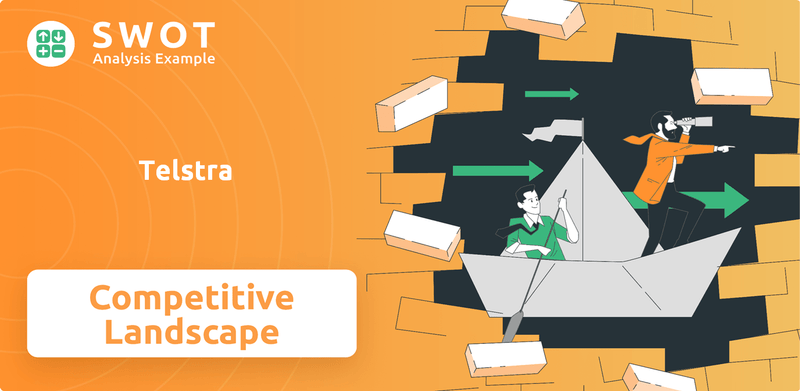
To truly understand Telstra's position, we must dissect its Telstra SWOT Analysis, its key competitors, and its market share within the Australian telecom market. This analysis will explore Telstra's strategies, from its mobile network dominance to its broadband service competition, revealing how it tackles challenges and aims for future growth. Examining Telstra's competitive landscape provides critical insights into the broader telecommunications industry and its impact on consumers and businesses alike.
Where Does Telstra’ Stand in the Current Market?
Telstra currently holds a commanding position within the Australian telecommunications industry. Its market presence is especially strong in mobile and fixed-line broadband services. The company's extensive infrastructure and large subscriber base contribute to its dominant market share. The company's strategic focus includes expanding its 5G network and enhancing digital service capabilities.
Telstra's primary offerings include mobile and home internet services, voice services, and a growing portfolio of digital solutions. These solutions are tailored for businesses. Geographically, its operations are concentrated in Australia, where it serves a diverse customer base. This base ranges from individual consumers and small businesses to large enterprises and government clients. Telstra is evolving beyond traditional telecommunications, expanding into areas like health, security, and smart infrastructure.
Financially, Telstra demonstrates robust health compared to industry averages. For the first half of the 2024 financial year, Telstra reported total income of A$11.3 billion and a net profit after tax of A$1.0 billion. This financial scale supports continued investment in network infrastructure, technology, and service innovation, reinforcing its market leadership. Telstra's strategic focus on expanding its 5G network and enhancing digital service capabilities aims to solidify its dominance in key high-growth segments.
Telstra maintains the largest subscriber base in the Australian mobile market. Its network covers 99.5% of the Australian population, ensuring extensive reach. The company reported 20.3 million retail mobile services in the first half of the 2024 financial year. This highlights its significant market share and strong competitive position.
Telstra is a major player in the fixed broadband sector. It leverages its extensive infrastructure and co-existence with NBN Co to provide services. This enables Telstra to serve a large customer base with reliable and widespread broadband access. Telstra's strategy includes enhancing its broadband offerings to maintain a competitive edge.
Telstra is diversifying its offerings beyond traditional telecommunications. This includes moving into areas such as health, security, and smart infrastructure. This strategic shift reflects a broader move towards becoming a technology company. This diversification aims to capture new growth opportunities and strengthen its market position.
Telstra's financial performance supports its market leadership and future investments. The company reported total income of A$11.3 billion and a net profit after tax of A$1.0 billion for the first half of the 2024 financial year. These results enable Telstra to invest in network infrastructure and innovation. This financial strength helps Telstra maintain its competitive edge.
Telstra's strategy focuses on maintaining its market leadership through network expansion and service innovation. A key element of this strategy is the expansion of its 5G network. This expansion aims to enhance digital service capabilities. This approach is designed to solidify Telstra's dominance in high-growth segments. For more information about Telstra's strategies, see the Growth Strategy of Telstra.
- Focus on 5G network rollout and expansion.
- Enhancement of digital service capabilities.
- Strategic diversification into new technology areas.
- Investment in network infrastructure and innovation.
Telstra SWOT Analysis
- Complete SWOT Breakdown
- Fully Customizable
- Editable in Excel & Word
- Professional Formatting
- Investor-Ready Format
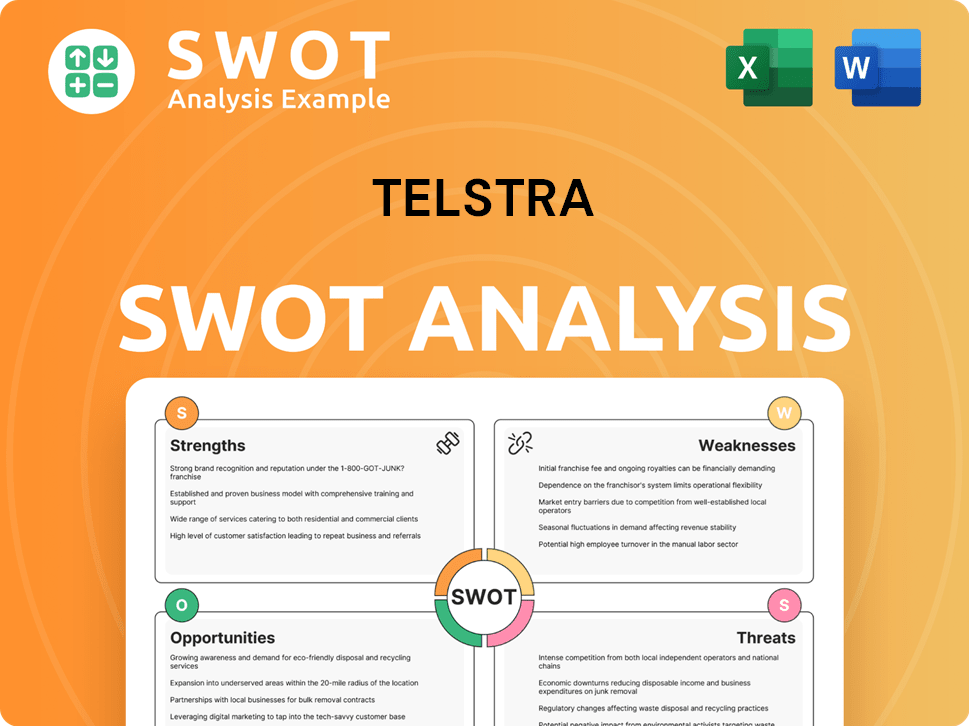
Who Are the Main Competitors Challenging Telstra?
The Telstra competitive landscape is shaped by a dynamic interplay of established players, emerging technologies, and evolving consumer preferences. Understanding Telstra's competitors and their strategies is crucial for assessing its market position and future prospects in the Australian telecom market. The telecommunications industry in Australia is characterized by intense competition, with companies constantly vying for market share and customer loyalty.
Telstra's market share is influenced by its ability to innovate, adapt to technological changes, and effectively compete on price and service quality. The company's strategic decisions, including investments in network infrastructure and acquisitions, play a significant role in shaping its competitive advantage. Analyzing Telstra's strengths and weaknesses analysis, along with the strategies of its rivals, provides valuable insights into the company's performance and potential for growth.
The competitive environment also includes regulatory factors that impact the Telstra strategy and its ability to compete effectively. The regulatory environment influences the pricing of services, network access, and the overall structure of the industry. The company's financial performance is closely tied to its ability to navigate these challenges and capitalize on opportunities within the market.
Optus and TPG Telecom are the primary direct competitors to Telstra in the mobile market. Optus, a subsidiary of Singtel, is a major player with a significant subscriber base. TPG Telecom, formed from the merger of TPG and Vodafone Hutchison Australia, competes aggressively in both mobile and fixed broadband markets.
In the fixed-line broadband sector, Optus and TPG Telecom are also key competitors. Numerous smaller internet service providers (ISPs) operating on the National Broadband Network (NBN) offer competitive pricing. These ISPs often focus on specific customer segments or geographic areas.
Telstra competes with global technology companies and specialized IT service providers in the enterprise and business solutions segment. These competitors offer cloud services, cybersecurity, and managed network solutions. Competition is fierce in this area, with a focus on innovation and service quality.
Mobile Virtual Network Operators (MVNOs) operate on the networks of Telstra, Optus, and TPG, providing consumers with more choices and often lower prices. MVNOs increase competitive pressure in the mobile market. These operators target specific customer segments with tailored offerings.
Satellite internet services, such as Starlink, present an alternative for customers in regional and remote areas, traditionally strongholds for Telstra's fixed-line services. This technology offers a competitive option in areas with limited broadband infrastructure. Starlink is expanding its coverage and customer base.
Mergers and alliances, like the TPG-Vodafone merger, reshape the competitive dynamics by creating stronger, more diversified rivals. These combinations can lead to increased market share and broader service offerings. Such strategic moves impact market structure.
The Telstra competitive landscape is characterized by intense promotional campaigns, aggressive pricing strategies, and continuous efforts to differentiate through network quality, customer service, and innovative product bundles. The ongoing competition in 5G network rollout and coverage is a key battleground, with each major player vying for superior performance and reach. Understanding Telstra's financial performance compared to competitors requires a detailed analysis of their respective strategies and market positions.
- 5G Network Rollout: Telstra, Optus, and TPG are heavily investing in 5G infrastructure. As of early 2024, Telstra's 5G network covers over 80% of the Australian population, while Optus and TPG are also rapidly expanding their 5G coverage.
- Pricing and Bundling: Competitors frequently offer bundled services that include mobile, broadband, and entertainment options to attract customers. Telstra's pricing strategies compared to competitors often involve premium pricing for superior network quality and customer service.
- Customer Service and Innovation: Customer service quality and innovative service offerings are crucial for differentiating in the market. Telstra's focus on these areas helps it retain customers and attract new ones.
- Market Share: In the mobile market, Telstra holds a significant market share, followed by Optus and TPG. In the fixed broadband market, NBN Co. (the National Broadband Network) plays a significant role, with various ISPs competing for market share.
- Recent Developments: Recent acquisitions and partnerships, such as Telstra's infrastructure deals, impact the competitive landscape. These moves aim to strengthen Telstra's position and improve its service offerings.
For a deeper dive into the company's financial strategies, consider exploring the Revenue Streams & Business Model of Telstra.
Telstra PESTLE Analysis
- Covers All 6 PESTLE Categories
- No Research Needed – Save Hours of Work
- Built by Experts, Trusted by Consultants
- Instant Download, Ready to Use
- 100% Editable, Fully Customizable
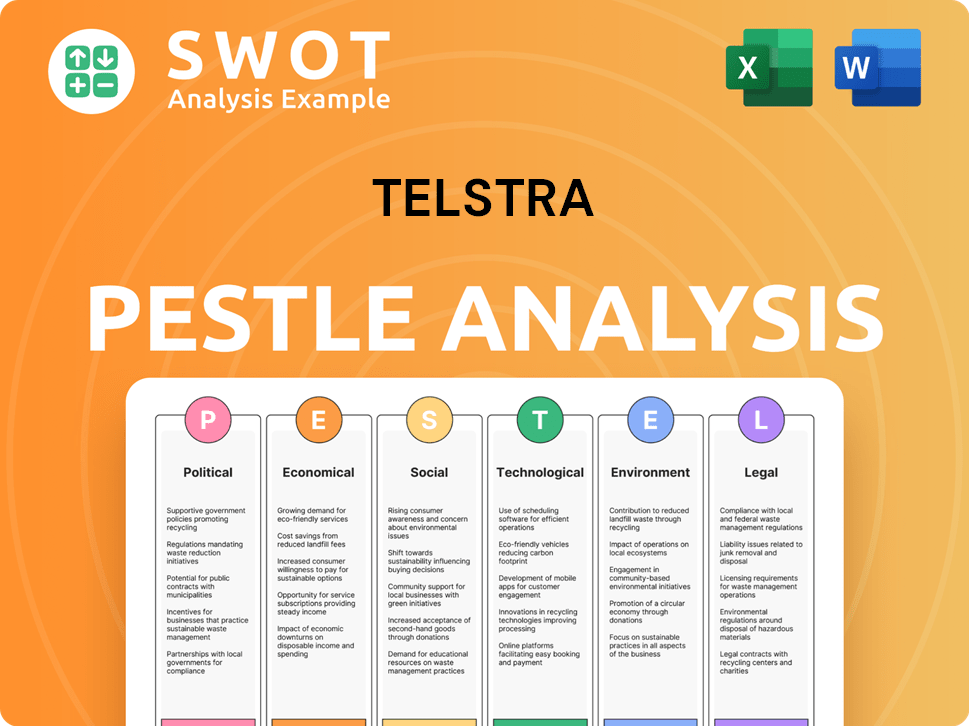
What Gives Telstra a Competitive Edge Over Its Rivals?
Analyzing the Target Market of Telstra, one finds that its competitive advantages are largely built upon its extensive network infrastructure, strong brand recognition, and a substantial customer base. These elements create significant barriers to entry for competitors in the Australian telecommunications industry. Telstra's strategic moves and investments have consistently aimed at fortifying these advantages, ensuring its position in a dynamic market.
Telstra's mobile network, with coverage reaching 99.5% of the Australian population, is a key differentiator. This widespread reach, particularly in regional and remote areas, provides a reliable and accessible service, contrasting with the limited presence of some competitors. Furthermore, the company's ongoing investment in 5G technology enhances network performance and capacity, critical for both consumer and business clients. This focus on infrastructure ensures superior service delivery, supporting its competitive edge.
Brand equity and customer loyalty also represent significant strengths. Telstra has cultivated a trusted brand in Australia over decades, translating into a loyal customer base. Its substantial customer base provides economies of scale, enabling greater investment in network upgrades, research and development, and customer service. This scale is crucial in a competitive landscape where innovation and customer satisfaction are paramount.
Telstra's expansive network infrastructure, including its 5G rollout, is a primary competitive advantage. This infrastructure provides wide coverage and superior network performance. The company's investment in technology is a key factor in maintaining its market position.
Telstra's established brand and customer loyalty are significant strengths. The company's long-standing presence in the market has built trust. This loyalty helps Telstra retain customers even amidst aggressive pricing from competitors.
Telstra's diversification into digital solutions and managed services is a strategic move. This includes cybersecurity, cloud services, and IoT solutions. It allows Telstra to offer integrated technology solutions.
Telstra's large customer base provides significant economies of scale. This enables greater investment in network upgrades, research, and customer service. These investments enhance its ability to compete effectively.
Telstra's competitive advantages are multifaceted, encompassing its extensive network, strong brand, and strategic diversification. These elements collectively position Telstra favorably within the Australian telecom market, influencing its financial performance and market share. The company's focus on innovation and customer experience is a key part of its strategy.
- Extensive Network Coverage: Reaching 99.5% of the Australian population with its mobile network.
- Brand Reputation: A well-established and trusted brand in Australia.
- Customer Base: A large customer base, providing economies of scale.
- Strategic Diversification: Expansion into digital solutions and managed services.
Telstra Business Model Canvas
- Complete 9-Block Business Model Canvas
- Effortlessly Communicate Your Business Strategy
- Investor-Ready BMC Format
- 100% Editable and Customizable
- Clear and Structured Layout
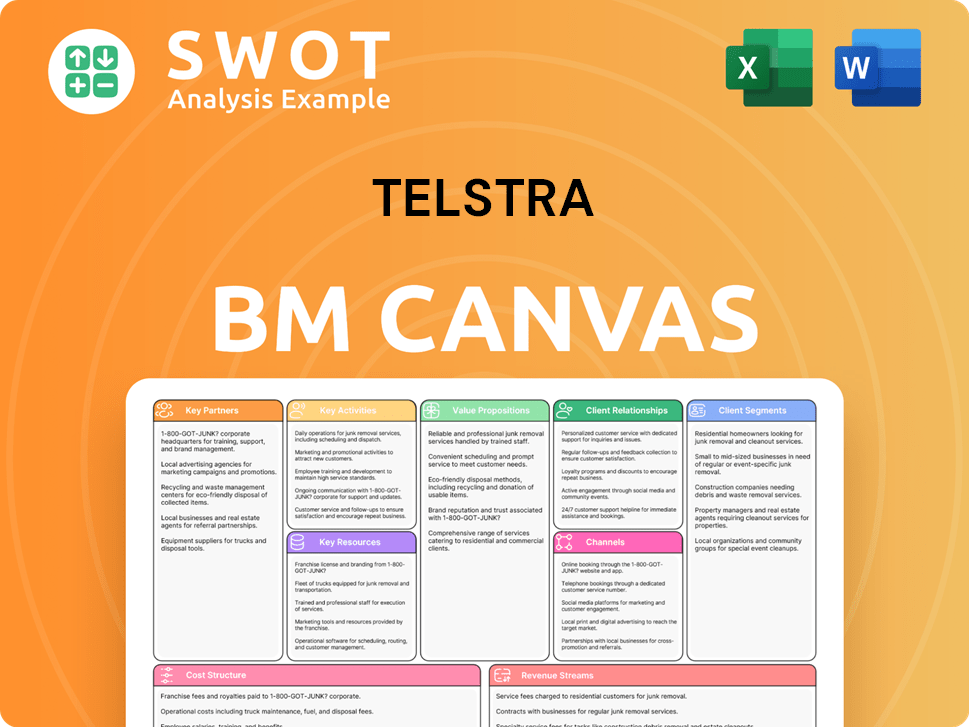
What Industry Trends Are Reshaping Telstra’s Competitive Landscape?
The telecommunications industry in Australia, and the wider Telstra competitive landscape, is undergoing significant transformation. Key drivers include the expansion of 5G, the growing need for high-speed broadband, and the convergence of IT and telecommunications services. These trends present both challenges and opportunities for major players like Telstra. Understanding Telstra competitors and the dynamics of the Australian telecom market is crucial for assessing its future prospects.
Telstra's market share is influenced by regulatory changes, such as those related to the National Broadband Network (NBN). Consumer preferences are shifting towards bundled services and digital engagement, which requires significant investment in digital platforms. The company faces intensified competition, declining demand for traditional voice services, and disruptive technologies, but also has opportunities for growth. For a deeper dive into the company’s strategic direction, consider reading about the Growth Strategy of Telstra.
The telecommunications industry is experiencing rapid 5G deployment, which offers faster speeds and lower latency. There is a growing demand for high-speed broadband, and a convergence of telecommunications and IT services. Regulatory changes and consumer preferences are also key drivers of industry evolution, impacting Telstra's strategy.
Intensified price competition from smaller players and MVNOs poses a threat to Telstra's market share. Declining demand for traditional voice services and the emergence of satellite internet also present challenges. Significant capital expenditure for network upgrades and expansion is also a financial burden.
Telstra can capitalize on the growing demand for enterprise digital solutions, such as cloud and cybersecurity. Expansion into emerging technologies like IoT and AI offers new revenue streams. Improving customer experience and simplifying product offerings, as outlined in its T25 strategy, are key to future growth.
Telstra's competitive position is expected to evolve through continued investment in network superiority and strategic partnerships. The company faces competition from Optus, TPG Telecom, and various smaller players in the Australian telecom market. Telstra's ability to adapt to technological advancements and regulatory changes will determine its success.
Telstra is focusing on network superiority, customer experience, and diversification into new technology services. The company is investing heavily in 5G and fiber infrastructure to maintain its competitive edge. These investments are crucial for addressing the challenges and capitalizing on the opportunities in the Telstra competitive landscape.
- Network expansion and upgrades, including 5G rollout.
- Enhanced customer service and digital platform improvements.
- Strategic partnerships to expand service offerings.
- Focus on enterprise solutions like cloud and cybersecurity.
Telstra Porter's Five Forces Analysis
- Covers All 5 Competitive Forces in Detail
- Structured for Consultants, Students, and Founders
- 100% Editable in Microsoft Word & Excel
- Instant Digital Download – Use Immediately
- Compatible with Mac & PC – Fully Unlocked
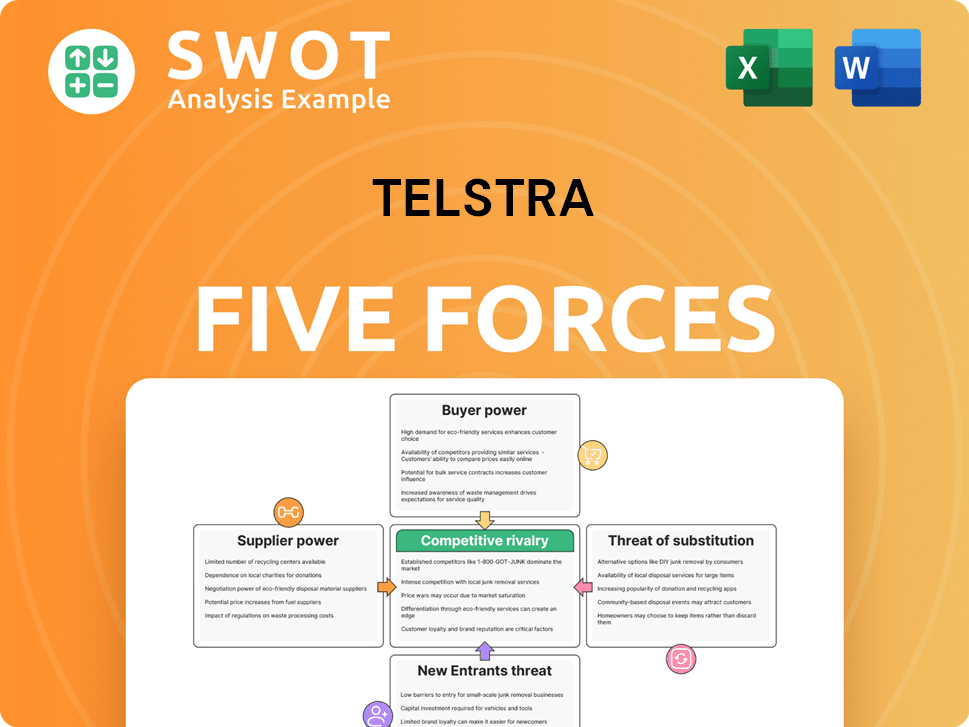
Related Blogs
- What are Mission Vision & Core Values of Telstra Company?
- What is Growth Strategy and Future Prospects of Telstra Company?
- How Does Telstra Company Work?
- What is Sales and Marketing Strategy of Telstra Company?
- What is Brief History of Telstra Company?
- Who Owns Telstra Company?
- What is Customer Demographics and Target Market of Telstra Company?
Disclaimer
All information, articles, and product details provided on this website are for general informational and educational purposes only. We do not claim any ownership over, nor do we intend to infringe upon, any trademarks, copyrights, logos, brand names, or other intellectual property mentioned or depicted on this site. Such intellectual property remains the property of its respective owners, and any references here are made solely for identification or informational purposes, without implying any affiliation, endorsement, or partnership.
We make no representations or warranties, express or implied, regarding the accuracy, completeness, or suitability of any content or products presented. Nothing on this website should be construed as legal, tax, investment, financial, medical, or other professional advice. In addition, no part of this site—including articles or product references—constitutes a solicitation, recommendation, endorsement, advertisement, or offer to buy or sell any securities, franchises, or other financial instruments, particularly in jurisdictions where such activity would be unlawful.
All content is of a general nature and may not address the specific circumstances of any individual or entity. It is not a substitute for professional advice or services. Any actions you take based on the information provided here are strictly at your own risk. You accept full responsibility for any decisions or outcomes arising from your use of this website and agree to release us from any liability in connection with your use of, or reliance upon, the content or products found herein.